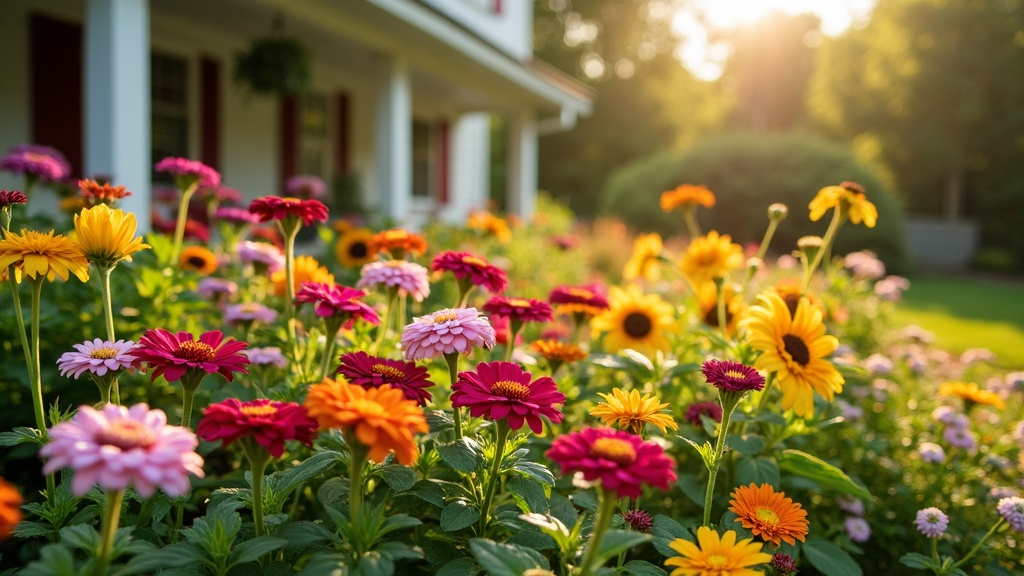Annual flowers bring bursts of color and life into gardens, giving everything a fresh and welcoming look. Choosing which ones to plant might be a little intimidating at first, just from the sheer number of options. I’ve pulled together my top 10 picks for annual blooms that work wonders for garden color all season long, adding energy to any outdoor space from early spring right through late summer and sometimes even into the fall.

Why Go for Annual Flowers?
Annuals are unique in the way they grow. They pop up, flower, set seed, and finish their whole life cycle in one growing season. While you get just one season with each plant, annuals know how to make it count, blooming longer and with more energy than a lot of perennials out there. This gives you a chance to switch up your flower beds every year or fill gaps between other plants. And because annuals bloom so reliably, they’re a great choice for gardeners wanting instant results.
Annuals have changed quite a bit over the years. Modern varieties are more resistant to disease and come in more colors than ever. These improvements mean gardeners get easy-care flowers that still stand out, making them especially good for beginners. Plus, you don’t need to make any big, long-term commitments. If you’re not thrilled with this year’s look, you can always try something new next season.
If you step into your local garden center, you’ll stumble upon a dazzling selection of annuals arranged in neat rows. Some are bred for compactness and ease, making them ideal for containers or window boxes, while others are designed to pump up the show in large beds and borders. The flexibility of annuals is one of their biggest selling points. With so many options, you’ll find choices that meet just about any style, from classic cottage charm to minimalist modern spaces. You’ll even spot annuals that are perfect for cutting gardens, letting you bring next-level cool color indoors all season.
Picking the Right Annuals for Your Space
Getting your annuals to truly shine starts with matching the right flowers to their environment. Some annuals love soaking in full sun, while others handle shade better. Pay attention to the climate in your area, too. Here are a couple of key factors to help narrow down your choices:
- Sunlight Needs: Some annuals, like zinnias, crave direct sunlight all day. Others, like impatiens, prefer a bit of shade. Make sure you know how much sunlight your planting area receives before making a decision.
- Soil and Watering: Well-drained soil is usually best. Some annuals need more water, such as begonias, while others handle drought better, such as marigolds.
- Growth Habit: Compact bushy annuals fit window boxes and pots, while trailing options like petunias spill beautifully over basket edges.
It’s also a good idea to think through your garden’s overall look. Do you want bold, blocky color, or a more textured, layered style? Annuals range from neat, rounded plants to tall, wispy types that add movement and interest. When choosing, consider plant height and how colors will look side by side. Sometimes mixing contrasting and complementing shades creates a display that grabs everyone’s attention from the curb.
Quick Guide: Top 10 Annual Flowers to Brighten Your Garden
I love mixing and matching annuals to see what combinations work best each year. Here are 10 annuals I recommend for a lively, colorful garden:
- Petunia: Incredibly versatile and easy to grow. Petunias provide bold colors, fun ruffled edges, and a long blooming period. Great for flower beds, hanging baskets, or pots.
- Marigold: Known for their golden yellow and orange blooms. Marigolds are also super useful because they help repel pests from the garden, especially around vegetables.
- Zinnia: These come in every shade imaginable, from hot pink to red, orange, and yellow. Zinnias love full sun and are really tough, making them great for hot, dry areas.
- Impatiens: Perfect for shadier spots, impatiens deliver clusters of bright flowers in white, pink, purple, and red.
- Begonia: With their bold leaves and colorful blooms, begonias perform well both in part shade and sun, depending on the variety. Wax begonias are especially low maintenance.
- Cosmos: These tall, airy annuals bloom in shades of pink, white, and deep maroon. Cosmos flowers keep coming as long as you keep snipping off faded blooms.
- Sunflower (Dwarf Varieties): Sunflowers aren’t all tall giants; dwarf versions fit right into smaller flower beds and containers, offering cheery yellow and orange faces.
- Lantana: Sometimes treated as a perennial in warmer areas, lantana is an annual in cooler spots. It’s drought tolerant and produces clusters of yellow, orange, red, or even purple blooms.
- Salvia: With their spiky blue, purple, red, or white flowers, salvias attract hummingbirds and butterflies to the garden.
- Sweet Alyssum: Compact and fragrant, sweet alyssum forms low mounds of tiny white, purple, or pink flowers. I find it works especially well as a border plant or a fill-in for places that need a gentle touch of color.
Tips for Getting the Most Out of Your Annuals
Once you’ve picked which annuals you want, making sure they do their absolute best is pretty simple if you keep these tips in mind:
- Start with Healthy Plants: Whether you’re growing from seed or buying transplants, strong diseasefree plants get established quickly and are more likely to bloom well.
- Feed Them Right: Annuals are heavy feeders. A slow release fertilizer when planting, plus a little boost every few weeks, pays off with more blooms.
- Deadhead for More Flowers: Snipping off faded blooms convinces many annuals, like zinnias, petunias, and cosmos, to keep producing flowers.
- Keep an Eye on Water: Most annuals need regular watering, especially in hot summer weather. Water at the base of the plant to avoid damp leaves, as this can invite disease.
- Mulch Helps: A couple of inches of mulch will keep moisture in the soil, help stop weeds, and steady soil temperature.
It’s worth remembering that annuals do best when you check in with them often. Look for signs of stress, like wilted leaves or no flowers, and adjust care if needed. Sometimes adding a bit more compost or moving pots to a shadier spot during a heatwave makes all the difference. Extra attention goes a long way toward a healthy, lush display.
Things Worth Thinking About Before Planting Annuals
Even low-hassle annuals come with a few quick things to think about. Here’s what I’ve learned over the years:
- Spend and Replant: Annuals flower like crazy but only last one season, so you’ll probably want to budget for replacements each year.
- Pest Patrol: Aphids and other pests sometimes find annuals tasty. Keeping a close eye on your plants and cleaning up old leaves or debris keeps problems in check. I like using insecticidal soap or bringing in ladybugs for natural pest control.
- Weather Luck: Spring cold snaps or summer heat waves can surprise even the hardiest annuals. Checking weather and moving pots to safety during extremes can save your flowers.
- Space to Grow: Crowding annuals limits how well they flower, so leave enough space for air to circulate.
Extra tip: Don’t be afraid to experiment, even after planting. If an annual seems unhappy in one spot, try moving it—sometimes a sunnier or shadier corner makes all the difference. And be sure to clean up spent plants at season’s end to keep your beds tidy and ready for next year’s planting spree.
Budget Friendly Tips
One of my favorite tricks is to start annuals from seed indoors to save money, especially if you’re filling a large flower bed. Many annuals, like zinnias and marigolds, are super easy to grow straight from seed, making them a lot cheaper than buying fullgrown flats at the garden center.
If you want to save even more, collect seeds from your fading annuals at the season’s end. Store them in a cool, dry spot—next spring, you’ll have homegrown seeds to jumpstart your display at virtually no extra cost. This can also let you experiment with new color combos, since some hybrid annuals toss out surprises in their second generation.
Advanced Annual Flower Hacks
You can get some pretty cool results by mixing annuals in new ways or giving them a creative spot in your garden. Here are a few things I’ve tried that work surprisingly well:
Layer Your Beds: Plant taller annuals, like cosmos and sunflowers, toward the back and shorter ones like alyssum or petunias at the front. This setup gives beds a fuller, more dynamic look.
Go Vertical: Use trailing types like nasturtiums, lobelia, or trailing petunias in hanging baskets or window boxes for that waterfall effect. It adds another level of color and looks super lush.
Mix for Pollinators: Tucking in annuals like salvia, cosmos, and lantana attracts bees, butterflies, and hummingbirds, which help pollinate other plants and keep the whole garden buzzing.
Another hack: try mixing edibles—think colorful lettuces or purple basil—among your annuals for a visually engaging and practical garden bed. Not only do these add interest, but they also give you a snack as you work or relax in your garden. If you feel creative, blend annuals in unexpected combinations, like pairing chartreuse foliage beside deep purple blooms, to make certain areas really pop.
RealLife Annual Garden Examples
I’ve seen front porches totally transformed with just a few pots of red and white petunias, or blank fences come alive with bright zinnias and cheerful marigolds. Even shady corners that usually look gloomy can pop with impatiens and begonias. Annuals give so much flexibility, whether you’re going for uniform color or a wild rainbow mix.
- Border Gardens: Alyssum along pathways for a sweet scent and tidy appearance.
- Container Displays: Mix trailing petunias with upright salvias and groups of marigolds in patio pots.
- Backyard Flower Beds: Tall zinnias, cosmos, or dwarf sunflowers lend height and draw eyes upward, making even a small bed feel big and bold.
Don’t forget, annuals aren’t just for single plantings. Create themed displays—think patriotic red, white, and blue for summer holidays, or a sunset palette of oranges, golds, and pinks for evening drama. Mix in foliage plants, like dusty miller or coleus, for extra texture and contrast throughout the season.
Frequently Asked Questions
Question: When should I plant annuals?
Answer: After the last frost in your area, when soil is warm and nights are mild. Most annuals don’t like cold weather.
Question: How do I keep annuals blooming longer?
Answer: Deadhead faded flowers, feed every few weeks, and keep them well watered, especially during heat waves. Mulching helps too.
Question: Can annuals grow alongside perennials?
Answer: Absolutely! Annuals are super useful for plugging gaps in perennial beds. They fill in spaces and add splashes of color while waiting for slowgrowing perennials to catch up.
The Bottom Line on Growing Annual Flowers
Annual flowers are one of my favorite ways to bring guaranteed color and energy to a garden, big or small. There’s nothing like seeing a blank flower bed come alive in just a few weeks. With a bit of planning and care, these blooms keep your garden vibrant from spring until the first fall frost, no experience needed.
Trying out different annuals each year keeps gardening interesting and gives you tons of room for creativity. Pick a few from this list, and you’ll be off to a great start with a brighter, more inviting garden space. If you’re ever unsure what to plant, just check in with fellow gardeners or browse local gardens for inspiration—there’s always something new and eye-catching to try.
